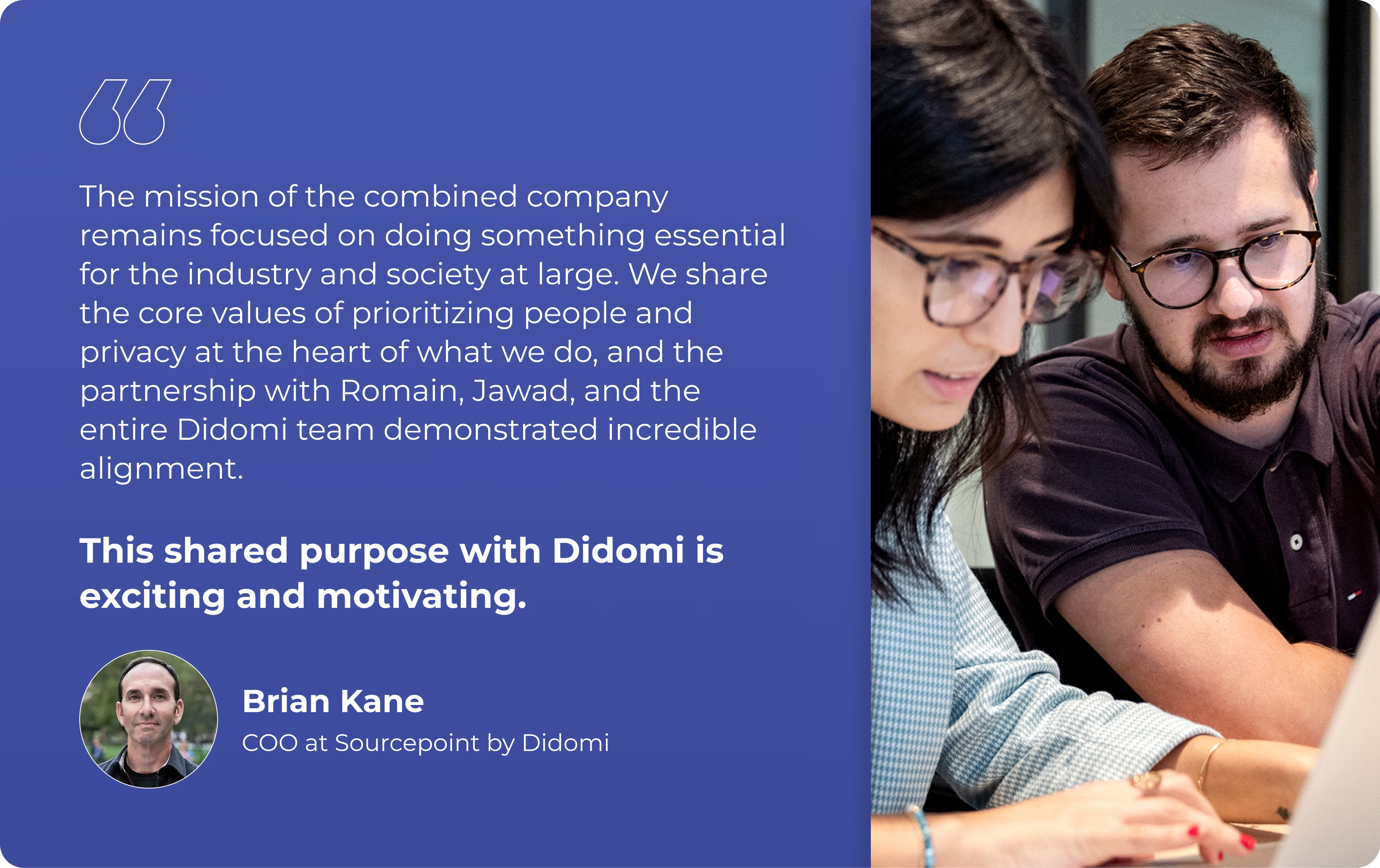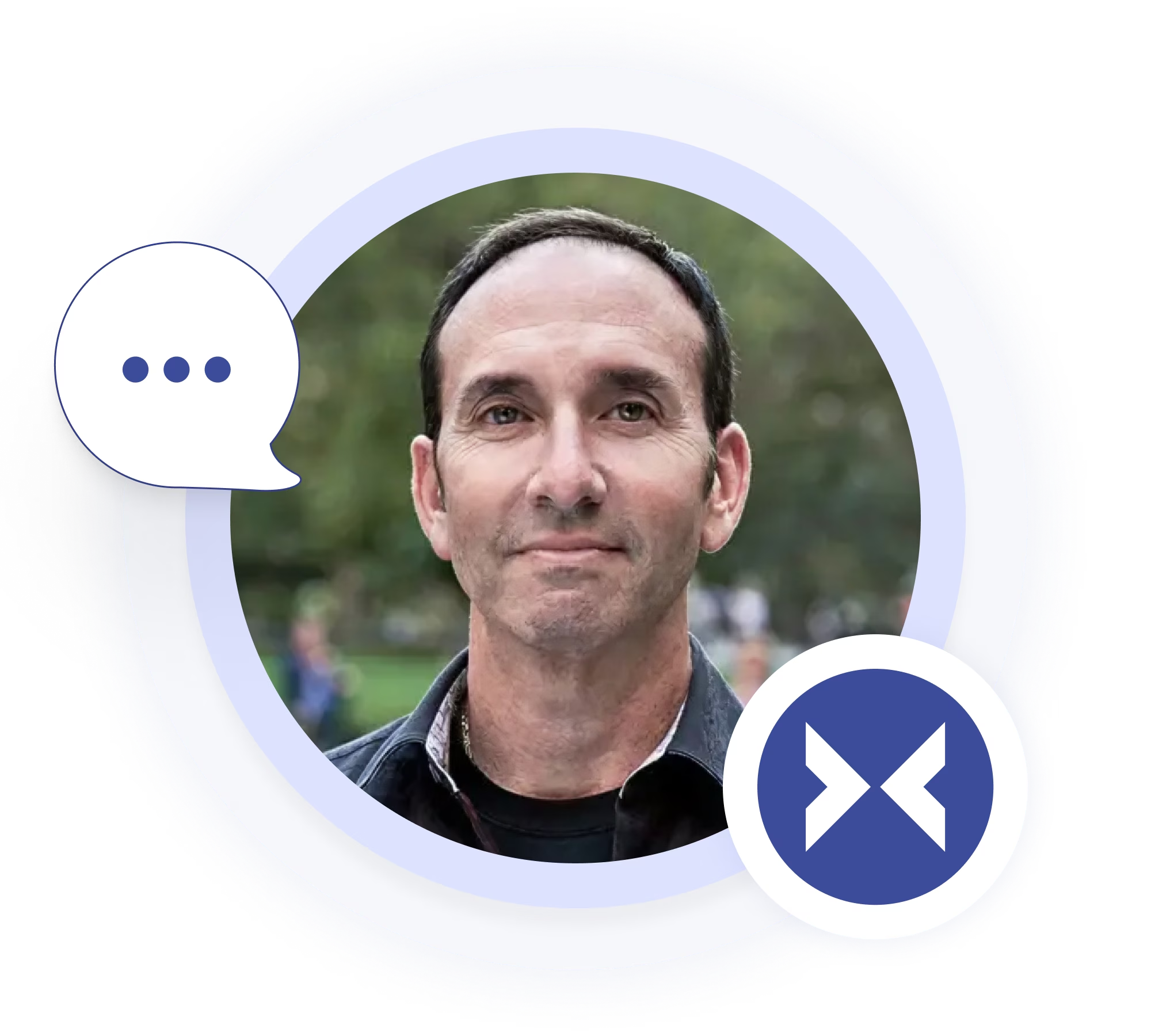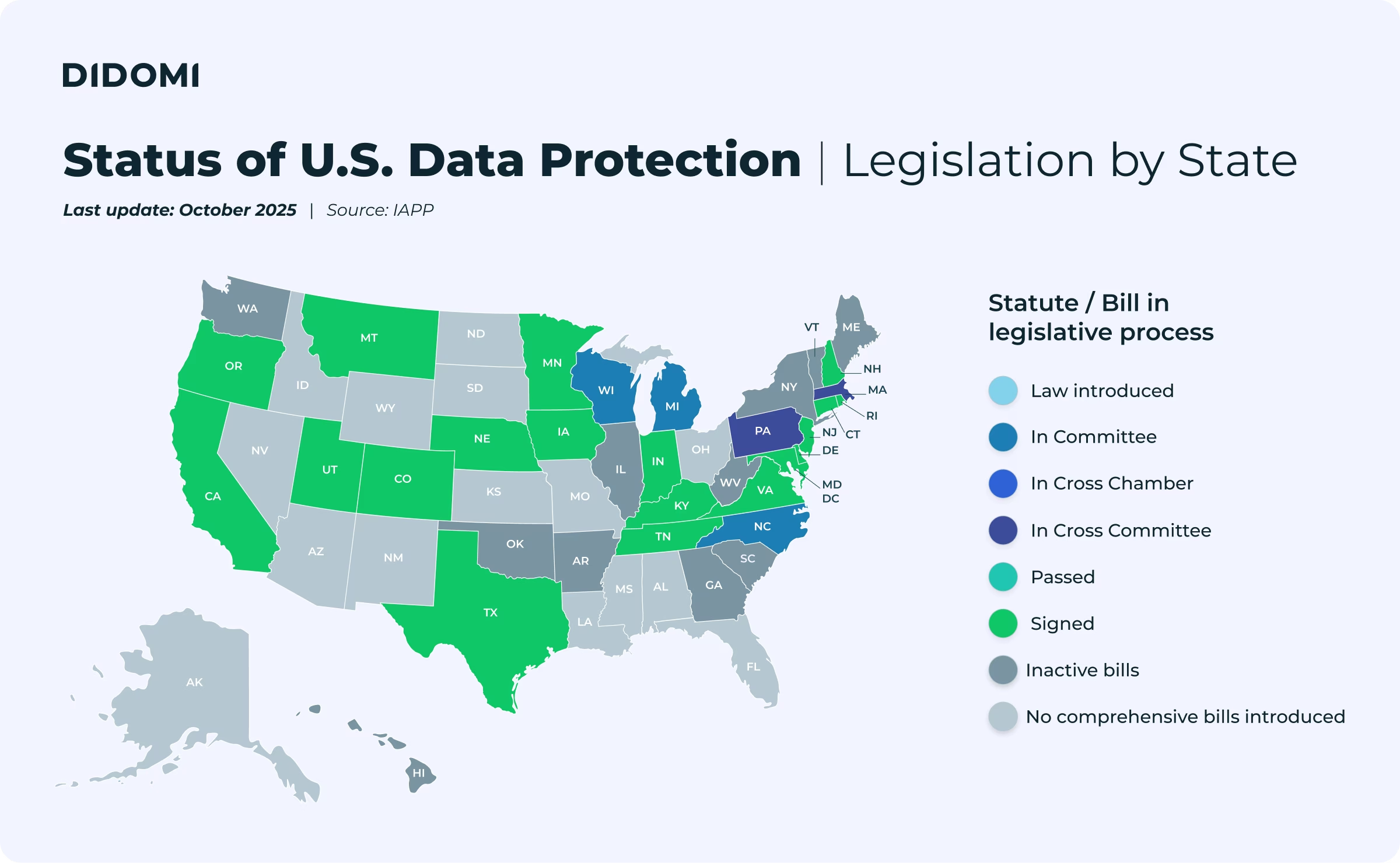In our interview series, we meet with data privacy leaders from various industries to learn about their experiences, projects, and perspectives.
Do you have an interesting perspective you’d like to share? Contact us at blog(at)didomi(dot)io.
Brian Kane is the Chief Operating Officer (COO) and co-founder at Sourcepoint, and joined Didomi a few months ago, along with the rest of his team. A true New Yorker with decades of experience in the tech space, he brings a wealth of knowledge, from being an early adopter of advertising technology to experience in several M&A operations throughout his career, both on the acquired and buyer sides.
We sat down with Brian to learn about his background, his perspective on the data privacy and advertising landscape, what joining Didomi meant for him and his team, and how he envisions the future for the combined company.
From kitchens to call centers: lessons in resilience and service

Didomi: Before entering the technology sector, you had a rich background, including work in the music and restaurant industries. What were those early roles like, and what crucial lessons did you take from them?
Brian: I worked for an individual in the music business early on who was incredibly tough, but also truly client-centric. As the fourth and lowest assistant on her list, my job mainly consisted of being yelled at all day long [laughs], but it toughened me up, and I was able to learn a great deal about customer service.
Later, I decided to go into business with my father, and we opened a restaurant in 1995. We built it from scratch, which, in retrospect, can be likened to a startup. I had no prior experience in that business, but I eventually became the executive chef and did everything. When the restaurant failed, I was left even more motivated to succeed.
How did you transition from that intense hospitality background into the world of technology?
I have always been drawn to computers and technology, so in 1997, I talked myself into taking a job at Bloomberg Financial Markets as a customer service representative. That was where my career in technology truly began. I recently told the Didomi Customer Success team in Paris that I will always have a very soft spot for customer success, because that is really where my first start in technology began.
I saw an opportunity to move on when I noticed a New York Times article (this was before the online version) about DoubleClick opening a New York office that was building a basketball court. The internet was really starting to come into its own. I saw a help-wanted ad for customer service roles, but I was focused on leadership, so I sent an email stating I was interested in managerial positions.
I joined DoubleClick in July 1999. Looking back, it was a good example of proactivity, luck, and timing that led me into that environment.
Surfing the first wave of AdTech, and learning the value of privacy early

You joined DoubleClick right at the beginning of the ad tech boom. What was that environment like, and what was your first experience with data privacy issues?
It was a fantastic environment. My team supported both of DoubleClick’s core offerings: the ad network, which helped monetize websites, and DFP (DART for Publishers). DFP was groundbreaking; it was the first time a publisher could utilize DoubleClick's technology while selling their ad space directly.
It was also my very first exposure to privacy issues in 1999. DoubleClick acquired Abacus Direct, a direct mail cooperative, with the intention of matching offline data (from catalogs and credit card numbers) with online user data. That product, called Boomerang, was way ahead of its time, but it sparked a significant privacy battle that involved the New York Attorney General. Ultimately, DoubleClick had to commit to refraining from specific actions with that data to continue operating.
I spent eight or nine years at DoubleClick. When the dot-com bubble burst around 2001, I was responsible for doing a bunch of compression for the company. I moved to Colorado to open a call center there because it was cost-effective to do so. I hired everyone in the Colorado office and spent a year building it before returning.
DoubleClick was eventually acquired by Google. What was the experience of such a massive acquisition and integration like?
The company went private in 2005 for $1 billion, and the smart investors eventually sold DoubleClick to Google for $3.2 billion a couple of years later.
I was part of the integration team, and the process was both fascinating and very stressful. Google had previously experienced issues with integrating YouTube culture, so they mandated a vetting process for all DoubleClick employees.
I managed a team of approximately 120 people, and I had to present to a room of 12 Google employees to explain why each of them should be retained. To make matters worse, after a seven-month regulatory review, the welcome email from the CEO mentioned that they would "probably let go of 20% of the company". It gave me very valuable exposure to a process that can go right or wrong.
After that major acquisition, you left Google and joined AdMeld. What prompted that move?
I spent about a year at DoubleClick within Google, but managing there proved to be challenging. It involved very cumbersome and burdensome manager overhead, and I had very little connectivity with customers. It just wasn’t for me.
I was approached by Ben Barokas on LinkedIn in late 2008 to have lunch and discuss the company he had started. I felt very special that a company founder would reach out to me, and I was definitely looking to work at a smaller company as a Chief Operating Officer, expanding my role beyond customer success. When I joined AdMeld in early 2009, I proactively expanded the conversation to include HR, since they didn't have anyone handling people operations.
AdMeld was pivotal in programmatic advertising. What was the innovation that led to its acquisition by Google?
AdMeld entered the market in 2009, immediately following the housing crisis, when the market was suffering. Our first product was ad network optimization, which was a very well-timed pitch for publishers. We essentially told them they didn’t have to pay us anything, and that if they worked with us, they would make more money.
We were also at the forefront of defining the standards for RTB (Real-Time Bidding) and programmatic advertising.
What really made a splash and caught Google's attention again was a product called Private Exchange, or private marketplace. This allowed large clients, such as Weather.com (one of my first customers, whom I’ve managed for 25 years), to curate a select group of programmatic buying partners. Google acquired AdMeld in 2011 for $400 million.
Your pattern of working with successful, high-growth companies continued after AdMeld. Could you briefly discuss MoPub and LiveRail?
After a three-month transition at Google, I joined MoPub, a mobile publishing platform, as an advisor, and it was eventually acquired by Twitter. That deal, after the IPO, ended up being worth over $700 or $800 million.
In 2012, I joined Live Rail, a video advertising platform. We worked to mature the business, reaching $100 million in revenue within two years, and were acquired by Facebook for $500 million in 2014. It was an incredible run.
Starting Sourcepoint to bring a transparent value exchange to the digital marketing ecosystem
After so many high-profile exits, what motivated you to start Sourcepoint in 2015, and what was the core problem you aimed to solve?
I reconnected with Ben Barokas in 2015, just as adblocking was all the rage.
We had a long-standing belief, dating back to DoubleClick, that we were keeping the internet free and promoting the democratization of information by ensuring publishers could sustain themselves through meaningful ad revenue.
We felt that adblocking was just a symptom. The actual problem was the lack of transparency between websites and consumers regarding two key issues: how ads funded content, and how data was being used. We believed that by bringing technology to the problem and allowing companies to offer transparent value exchange to consumers, the digital content ecosystem would remain sustainable.
How did Sourcepoint's initial offering evolve into a fully compliant Consent Management Platform (CMP)?
We launched our first transparency product, Dialogue, in 2016. This was the early framework of a CMP and was launched two years before the GDPR. The platform was all about choice and transparent value exchange. For example, users could choose to turn off their ad blocker or watch a video ad in return for accessing the content.
In early 2018, as the IAB put out specs for its framework, we developed a business plan to launch a formal CMP. We launched on GDPR Day, May 25, 2018. That was the second day in my career that I slept in the office (the first time was on the Y2K New Year's Eve at DoubleClick). We became CMP ID number 6, making us an early mover.
Did the shift to focusing on GDPR and compliance feel like a pivot from your original mission?
From an outsider perspective, it looked like we pivoted big time, but the core mission of transparent value exchange remained the same. For instance, ideas like "consent or pay" were an absolutely dead-on idea that we had in 2016. Consumers have more choice in a world where Sourcepoint and Didomi exist, regardless of whether they are aware of it or not.
The two worlds of adblocking and privacy truly came together in 2019/2020 when TCFv2 went into effect and Google joined the IAB. If a consumer rejected consent, their data wasn't used for ad personalization, and ads often wouldn't serve, leading to the same result as adblocking. It feels like the whole world has come full circle.
Europe, the U.S., and two paths to privacy

You've worked globally throughout your career. How does the European approach to data privacy compare to the U.S., and how has that driven the market?
I’ve been working with European companies since the very beginning of my career at DoubleClick. From a data protection standpoint, Europe has always been ahead of the US. We saw this early on when we published a paper in 2015 showing much higher ad block rates in Germany (30%) and France (25%) compared to the US (5%). This informed our launch strategy, leading us to open a GmbH from the beginning.
When GDPR launched, the US market largely adopted a "wait and see" strategy. Many U.S. companies chose to block European traffic, rely on legitimate interest, or try to build lightweight solutions themselves. Competitors like OneTrust even gave their CMP away for free, appealing to US clients who didn't care as much about the software investment.
What is driving the growing interest and investment in privacy software in the U.S. today?
While GDPR was the single major impetus for change in Europe, the shift in the U.S. is driven by a multi-pronged set of factors. I sometimes call it "death by a thousand cuts" [laughs].
Some of these factors include CCPA (mandating "do not sell and do not share") and subsequent state-based regulations, pixel litigation, children's privacy, and AI. U.S. enterprises now face constant uncertainty about potential lawsuits over the improper use of pixels or whether they can use data for marketing purposes.
There is a growing awareness in the U.S. that existing practices are not good enough for where they need to go.
Do consumers truly understand data privacy, and what role does the consent banner play in the continuum of data control?
Generally, there is a relative lack of awareness about data usage, period. Most consumers find things like probabilistic matching or seeing an ad for what their spouse was searching kind of insane. But consumer awareness is increasing, especially among the younger generation, who are more aware of what data their phones collect and of data breaches.
Twenty-five years ago, at DoubleClick, we weren't thinking about consumers at all. Now, companies are focused on giving consumers a choice. I view the consent pop-up not as a nuisance, but as a control panel. It gives me control as a consumer as to whether I want to accept data processing or not. Which I think, ultimately, is a good thing.
People, purpose, and a long-term home at Didomi

You and Ben Barokas have partnered successfully multiple times. What is the key to that effective recurring partnership?
Ben and I have been working together for 15 years now. Our strengths and working styles are highly complementary, which has enabled us to build a partnership based on trust and focus on what we respectively do best, in complete sync with each other.
It’s also been essential that we are aligned on our core values:
- People are at the core of what we do.
- Transparency is at the core of what we do. Internally and externally.
We have been living in that transparent culture for 10 years. We always put people first, and I truly believe that the Sourcepoint team, like the teams I've led previously, is the best in the business.
After achieving such great success, what drives your work today, particularly in relation to the Didomi partnership?
It’s a privilege to be in this line of work. I contrast it with my previous low-leverage roles, like cooking in my restaurant, in a startup with funding and great people, the levers are so powerful. My job as a leader is simply to show up and create an environment where they can do their best work. It's the best job in the world.
When Ben and I founded Sourcepoint, we wanted to do something bigger, different, and important. We are still not done with that mission. Every single day, we do something that I believe makes the world better through transparency. We resisted pressure to pursue less "pristine" directions and stayed true to that vision.
This recent transaction with Didomi is different from your previous M&A. What makes you committed to the combined company for the long term?
My previous acquisitions at AdMeld and Live Rail were structured to be shorter transitions, but this merger with Didomi is fundamentally different, and I'm here for the long term. This is the first time I really go in with that mindset.
It comes down to mission alignment and strategic backing. The mission of the combined company remains focused on doing something essential for the industry and society at large. We share the core values of prioritizing people and privacy at the heart of what we do, and the partnership with Romain, Jawad, and the entire Didomi team demonstrated incredible alignment.
This shared purpose with Didomi is exciting and motivating.
Crucially, the backing of Marlin Equity Partners is so critical for our success. They are operating with a playbook and providing the necessary infrastructure, framework, and funding to help us build a bigger business. I'm thrilled to go into this with a long-term mindset for the first time.
What are you most excited about in the future of data privacy, and what role do Sourcepoint and Didomi play in that vision?
Considering the evolution of data privacy, we don't think it will become simpler tomorrow than it was yesterday. For this reason, enterprises need partners who understand both the technology and the evolving regulatory landscape. I believe we are incredibly well-positioned to do that globally, together.
Coming together enables us to support the success of our clients in the data privacy space even more effectively, whether it's through consent management, compliance analytics, or, in the future, technology that facilitates success in AI.
We are actively engaged in building that future, and I’m very excited for what’s next.
---
To learn more about Brian and his work, follow him on LinkedIn and visit sourcepoint.com. Stay tuned for more information on Sourcepoint and Didomi soon.

.svg)
















